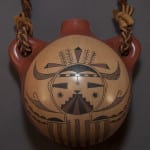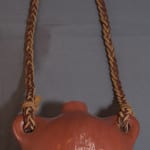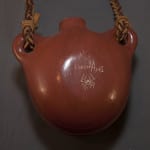Beautifully formed and precisely polished and painted, this canteen is typical of the work of Loren Ami. Loren is a good representative of the creative energy unleashed at Hopi when it became acceptable for men to make pottery.
The front third of the canteen is painted with an image of a Palik’Mana (“Water Woman”) who, although not a Katchina, dances at Hopi in ceremonies appealing for moisture and bountiful crops. At first glance, the design seems monochromatic. A closer look shows that Loren has used a pale brown slip to enhance much of the design. Only the stripes in her shirt are (barely) outlined with very thin and fragmented red lines.
The rear two-thirds of the canteen is covered with a red slip with some micaceous clay added. Given the exceptionally smooth surface of the canteen the result is a slight shimmer that energizes this surface.
Loren has a light hand: the Polik’Mana image is delicate. Add in the slight micaceous twinkle of the red-slipped areas and the subtle use of color variation in the Polik’Mana image, and the result is an elegant, understated gem. Canteen 2011-23 or (judging from a small photograph) one about identical to it is shown in Streuver (2001:94).
Born on the reservation in 1968, Loren grew up in Santa Fe, and moved with his Mother back to Hopi in his senior year of high school. His mother is not a potter, but on moving back to the reservation, he reacquainted himself with his grandmothers Eleanor Ami and Carol Namoki, both fine potters. He learned potting skills from them and began making pottery in the early mid 1980s. Later he was the companion of Camille Quotskuyva (Hisi), whose mother Dextra is the matriarch of her generation of Hopi-Tewa potters. Loren began helping Hisi and Dextra observed his skill and dedication. As she did with Les Namingha and Steve Lucas, Dextra became Loren’s mentor. Loren became known for his superb polish, fine painting and (especially) his canteens. In the 1999 Indian Market, he won first place in the canteen category.
The Palik’Mana image on canteen 2011-23 was also used on Nampeyo’s piki bowl in this collection (2009-17), a monumental contemporary jar by Rachel Sahmie (2012-01), and a cornmeal bowl (2012-05).





